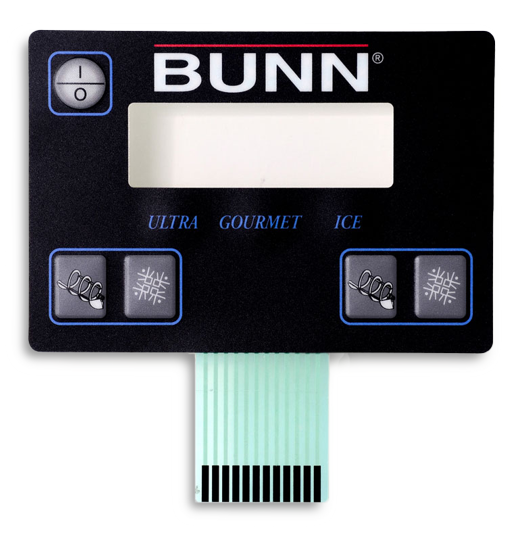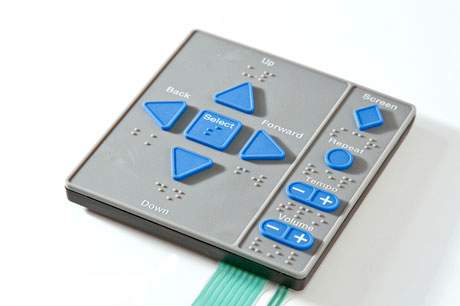Modern Technology from a Trusted Membrane Switch Manufacturer
Modern Technology from a Trusted Membrane Switch Manufacturer
Blog Article
Just How Membrane Switch Innovation Works and Its Function in Interface Style
Membrane button innovation is an advanced approach that combines split materials for touch-sensitive input. When pressed, its style is composed of graphic overlays, conductive layers, and adhesive components that interact. This interaction not just finishes an electric circuit but additionally influences the general user experience. Understanding the details of this innovation discloses its substantial influence on interface style, provoking questions about its applications and future growths in different industries.
Understanding Membrane Switch Technology
Membrane button innovation acts as an essential element in contemporary user interface style. This technology incorporates visuals overlays, touch-sensitive membranes, and circuit layers to develop a compact, trusted input technique for different tools. The style commonly contains numerous layers, consisting of a printed visuals layer that permits individuals to engage with the device via responsive feedback. Membrane switches are understood for their resilience, resistance to wetness, and ease of cleansing, making them ideal for settings where conventional mechanical buttons might stop working. Their inconspicuous style enables seamless assimilation into devices, adding to a sleek appearance. Furthermore, Membrane switches can be tailored with different shades, textures, and signs, boosting individual experience and aesthetic charm. This adaptability makes them preferred in consumer electronic devices, clinical gadgets, and commercial controls, where instinctive interaction is essential. Generally, Membrane switch technology represents a substantial development in just how customers engage with digital user interfaces.
Secret Components of Membrane Changes
Membrane switches include a number of essential parts that add to their capability and style. The conductive layer products, sticky and assistance layers, and visuals overlay style each play an essential duty in guaranteeing perfect performance and customer communication. Recognizing these parts is important for effective user interface design.
Conductive Layer Products
Conductive layer materials play a necessary duty in the capability and reliability of Membrane buttons. When stress is used to the button, these materials are accountable for completing electrical circuits. Commonly, a mix of conductive inks, such as silver or carbon, is used to produce these layers. Silver conductive ink is favored for its remarkable conductivity and resilience, while carbon ink is typically made use of for cost-effective applications. The option of product influences not just the electrical performance however also the total lifespan of the button. In addition, the density and make-up of conductive layers can affect responsive feedback and switch actuation. Selecting the suitable conductive product is essential for making certain perfect performance in diverse interface applications.
Sticky and Assistance Layers
Sticky and support layers are crucial parts that add to the architectural integrity and performance of Membrane buttons. These layers give a durable foundation, making certain that the various elements of the Membrane button stay securely bound and appropriately straightened throughout their operational life. The sticky layer assists in the attachment of the button to the underlying surface area, using durability against environmental factors such as dampness, temperature level variations, and mechanical stress. Meanwhile, assistance layers improve the switch's strength, avoiding deformation during usage and adding to a constant tactile reaction. With each other, these elements play a vital function in keeping the performance and long life of Membrane switches, ultimately influencing the overall individual experience in interface style.
Graphic Overlay Design
Although typically ignored, graphic overlay style plays a vital duty in the capability and visual appeals of Membrane buttons. This design primarily works as the interface between the customer and the electronics, offering both visual allure and operational clearness. Reliable visuals overlays make use of color, typography, and symbols to direct users in steering controls and understanding tool functions. Additionally, the choice of materials influences longevity and responsive responses, making certain the overlay stands up to wear while preserving an enjoyable individual experience. Additionally, exact placement of the overlay with the underlying parts is important for excellent performance. In verdict, thoughtful graphic overlay design enhances functionality, adds to brand name identity, and eventually influences customer complete satisfaction in gadgets making use of Membrane switch modern technology.
The Production Process of Membrane Changes
The production process of Membrane switches over entails several important steps that ensure functionality and resilience. At first, a visuals overlay is designed, including interface components and branding. This overlay is published onto a flexible substrate, typically polyester or polycarbonate, utilizing accuracy printing strategies to establish quality and color accuracy.Next, sticky layers are used, complied with by the assimilation of conductive traces, frequently made from silver or carbon, which are vital for electric connectivity. These traces are screen-printed or etched onto a separate layer. Hereafter, a spacer layer is included in produce the needed space between the circuit and the overlay layer, allowing for responsive responses when activated.Finally, the parts are constructed and examined for high quality assurance, assuring that each Membrane button fulfills the needed specs for efficiency and dependability. This careful procedure results in a durable item suited for various applications in interface layout.
Advantages of Utilizing Membrane Changes

Membrane changes offer countless benefits that make them a recommended choice in user interface design. One substantial benefit is their portable and lightweight nature, enabling structured layouts in numerous applications. In addition, Membrane switches give a sealed user interface, protecting versus dirt, moisture, and contaminants, which enhances sturdiness and integrity. They are likewise very adjustable, allowing designers to develop special graphics and layouts customized to details customer needs.Another benefit is their cost-effectiveness, as they typically call for much less material and labor contrasted to traditional buttons. The tactile comments of Membrane buttons can be engineered to improve user experience, providing a rewarding response without the bulk of mechanical elements. Furthermore, Membrane buttons can be easily incorporated right into diverse environments, such as medical devices, industrial tools, and consumer electronics. On the whole, these benefits highlight the growing appeal of Membrane switches in modern interface style.
Applications in Different Industries
Commonly utilized across different sectors, Membrane button modern technology has actually located its area in applications varying from medical devices to consumer electronics. In the health care market, these switches are essential to devices such as analysis devices and individual tracking systems, using long lasting, easy-to-clean user interfaces that endure sanitation procedures. The automobile sector utilizes Membrane buttons in dashboards and control panels, giving trusted operation in tough environments.Consumer electronic devices, consisting of home devices and gaming consoles, gain from the sleek design and customizability of Membrane buttons, boosting individual communication. Furthermore, commercial machinery makes use of these buttons for control board, ensuring resistance to dirt and dampness while preserving functionality.Moreover, the aerospace and military sectors use Membrane buttons for sturdy applications, where dependability and efficiency are vital. Overall, Membrane switch innovation offers varied industries by integrating Click Here capability, durability, and aesthetic allure, making it a flexible option for modern interface.

Creating Interface With Membrane Switches Over
When developing individual interfaces with Membrane buttons, cautious factor to consider of both performance and aesthetics is essential. Membrane switches provide a streamlined, inconspicuous design that can boost visual allure while preserving usability. Developers must concentrate on switch design, making certain instinctive placement for ease of operation. The responsive responses provided by the Membrane switch is important; it can influence user satisfaction and overall experience.Additionally, color and visuals aspects should straighten with the brand name identity, enhancing acknowledgment and knowledge. Selecting resilient products that stand up to deterioration is likewise essential, as longevity contributes to usability with time. Integrating backlighting can improve visibility in different illumination problems, even more enhancing user communication. Ultimately, a properly designed Membrane button user interface equilibriums both type and function, guaranteeing that the individual experience is both engaging and reliable, satisfying the demands of varied applications throughout sectors.
Future Trends in Membrane Switch Innovation
As Membrane button innovation advances, the assimilation of smart functionalities is ending up being increasingly noticeable. These developments enable improved interactivity and connectivity within individual interfaces (membrane switch manufacturer). In addition, the change towards green materials mirrors an expanding dedication to sustainability in style practices
Smart Membrane Switches Over

Eco-Friendly Materials Use
Among the developments in Membrane button technology, a substantial fad is arising in the direction of making use of green materials. Suppliers are increasingly focusing on sustainability by integrating eco-friendly plastics and safe inks, reducing ecological impact. This shift not only straightens with worldwide ecological standards however likewise addresses consumer demand for greener products. Developments in material science have made it possible for the advancement of sturdy, green choices that preserve performance without jeopardizing quality. These materials offer similar performance to conventional alternatives while lessening waste and poisoning. As markets end up being much more eco-conscious, the integration of sustainable practices in Membrane switch manufacturing is expected to climb, reinforcing a commitment to ecological responsibility and leading the way for more sustainable user interface solutions in the future.
Frequently Asked Questions
Exactly How Do Membrane Changes Differ From Typical Mechanical Switches?
Membrane switches over vary from standard mechanical switches largely in construction and operation. They utilize versatile layers that develop a sealed user interface, whereas mechanical buttons depend on physical activity and call, leading to distinct sturdiness and tactile feedback characteristics.
Can Membrane Switches Over Be Custom-made for Particular Applications?
Membrane buttons can certainly be customized for details applications - membrane switch manufacturer. Manufacturers create them to meet unique requirements, enabling customized layouts, graphics, and functionalities that boost customer interaction and fit certain operational requirements successfully
What Is the Life expectancy of a Membrane Layer Switch?
The lifespan of a membrane layer button normally ranges from 1 to 5 million actuations, relying on variables such as material quality, environmental conditions, and usage regularity. Normal screening can assist establish its long life and dependability in applications.
Are Membrane Switches Over Resistant or water-proof to Chemicals?
Membrane switches can be developed to be immune and water-proof to chemicals, relying on the materials utilized and making procedures. Appropriate securing and protective finishes enhance their sturdiness in numerous environmental problems and applications.
How Do Membrane Switches Over Influence Device Power Usage?
Membrane switches can significantly impact tool power intake by making certain efficient operation. Their reduced power requirements throughout activation help reduce energy use, adding to longer battery life and total improved efficiency in electronic gadgets. Membrane buttons are recognized for their resilience, resistance to moisture, and ease of cleaning, making them appropriate for settings where traditional mechanical buttons might stop working. The auto industry employs Membrane click reference buttons in control panels and control panels, offering dependable operation in challenging environments.Consumer electronic devices, including home appliances and gaming consoles, benefit from the streamlined layout and customizability of Membrane buttons, boosting individual interaction. Furthermore, industrial equipment makes use of these buttons for control panels, guaranteeing resistance to dust and moisture while preserving functionality.Moreover, the aerospace and armed forces industries utilize Membrane switches for tough applications, where dependability and efficiency are essential. The advancement of Membrane button modern technology is getting in an amazing stage with the development of wise Membrane buttons, which incorporate innovative functions and capabilities. Membrane switches over vary from conventional mechanical switches primarily in building and procedure.
Report this page